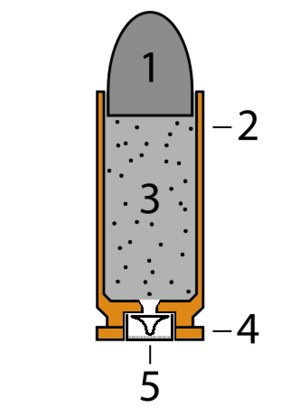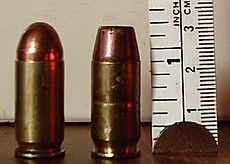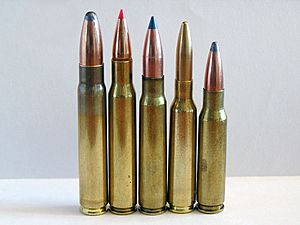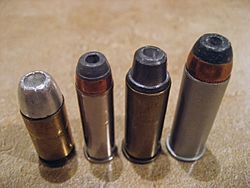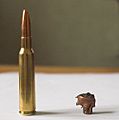Bullet facts for kids
Bullets are small metal objects. They are fired from guns. Many bullets are made from lead covered with copper. They are part of a package called a cartridge. The cartridge goes into a gun.
The bullet is at the front of the cartridge (number 1 in the picture). Hot gases push the bullet out of the gun. A powder called gunpowder (number 3) is inside the case (number 2). A small explosion from the primer (number 5) lights the gunpowder. The gunpowder burns very fast. This creates hot, high-pressure gases. These gases push the bullet out of the gun barrel quickly.
Bullets are weapons. Soldiers and police use them. People use them for self-defense. They are also used for hunting animals or for sport. Some people use them for target shooting. There are many kinds of bullets. Each gun uses a certain size, or caliber, of bullet. Rifles and handguns use different types. Sometimes a gun can use more than one kind of bullet.
The word "bullet" is often used for a whole cartridge. But a bullet is only one part of it. A full ammunition cartridge includes the bullet (the part that flies). It also has the case (which holds everything). There is the propellant (gunpowder) that makes it go. And finally, the primer starts the burning.
Contents
How Bullets Are Designed
Bullet designs must solve two main problems. A bullet needs to fit tightly inside the gun's barrel. If it is too loose, gas from the gunpowder leaks past it. This means the bullet won't be pushed out with full power. The bullet also needs to fit tightly against the rifling. Rifling means spiral grooves cut inside the barrel. This fit must be tight but not cause damage.
Bullets must fit tightly without too much friction. They must be made very carefully. Poorly made bullets might not fly straight. They can also damage the gun or hurt the person using it. How a bullet acts inside the barrel is called 'internal ballistics'.
How Bullets Fly
The rules of physics help us understand how a bullet moves. This is after it leaves the barrel. How a bullet acts after it leaves the gun is called 'external ballistics'. The bullet's shape is important for how it flies. The rotation from the gun's rifling also matters. Spinning helps keep the bullet stable, like a gyroscope. This spinning keeps it on track. Any small differences in the bullet's shape are mostly fixed as it spins.
The first guns did not have rifling. These were called smoothbore firearms. They used round bullets. Round bullets were best because they were the same no matter how they spun. But these bullets were not very stable. They were also not very accurate. Still, the round shape of bullets stayed the same for hundreds of years.
What Happens When a Bullet Hits
Bullet design also affects what happens when it hits something. How a bullet acts when it hits a target is called 'terminal ballistics'. Many things affect this. These include the target material and how dense it is. The angle the bullet hits at matters. The bullet's speed and design are also key.
Bullets are usually made to go into a target. They might change shape or break apart. For a certain material and bullet, the bullet's speed is the main thing that decides what happens. Making bullets go faster greatly increases their kinetic energy. This is a big effect. So, people have tried to make bullets lighter and faster.
Modern guns use much lighter bullets. They shoot them much faster than guns from World War I. This makes guns better in two ways. The magazine (where cartridges are held) can hold more of the smaller, lighter bullets. Also, the higher speed causes much more damage than older bullets.
Different Kinds of Bullets
Rifle Bullets
Rifles are used for target shooting and hunting. A rifle bullet can be described by how accurate it is. Its ability to go deep, its shape, size, and weight also describe it. There are many different kinds of rifle bullets.
The Full Metal Jacket (FMJ) is a common military bullet. It has a lead center (core). A strong metal coating (jacket) covers it. This jacket is usually copper. Sometimes it is made of steel. The FMJ does not spread out when it hits a target. It goes deep into its target. It is a general-purpose bullet. FMJ is not recommended for hunting. It is mostly for target shooting and military use.
The Jacketed Hollow Point (JHP) has a lead center. Lead shows at the tip. It also has a strong metal coating. The center of the tip has a hole (hollow point). This design makes the JHP spread out quickly when it hits a target. A hollow point in a rifle bullet can be very small, like a pin. When it's this small, the bullet goes faster. It still spreads out when it hits a living target. Some hollow point rifle bullets can spread to twice their original width. It is a good hunting bullet. This is because its energy transfers to the target at a certain depth. The jacketed hollow point is usually accurate and strong.
The plastic tipped bullet is a hollow point bullet. A hard, pointed plastic tip fills the hollow point. It is used because it can travel further than the JHP. It also does not curve as much. The plastic tipped bullet also spreads out or breaks into pieces when it hits the target.
A solid copper bullet has no lead core. It is made only of copper. This bullet expands into a flower shape when it hits a target. Copper bullets are usually hollow point. The copper bullet has no lead, which is better for the environment. In rifles, it is widely used for hunting and other sports.
A frangible bullet breaks into many pieces. This happens when it hits anything harder than itself. This bullet is used for safety while shooting. It has little impact on the environment. It also makes objects behind the target a little safer.
Handgun Bullets
Handguns are mostly used for sport target shooting or self-defense. Police use pistols because they are easy to carry. They can be ready to use quickly.
Pistol bullets have some names like rifle bullets. Examples are full metal jacket (FMJ) or jacketed hollow point (JHP). For instance, there are hollow point pistol bullets. They also spread out a lot when they hit a target. However, in a pistol bullet, the hollow point can be much larger. The hollow point makes the pistol bullet slow down faster. This is due to air resistance. But a pistol bullet does not need to travel as far as a rifle bullet. The hollow point in a pistol bullet can be almost as wide as the bullet itself. When a hollow point pistol bullet hits a target, it almost completely flattens. A solid copper pistol bullet is usually hollow point. It is mainly used for self-defense or target shooting.
A flat nosed bullet is mostly used in handguns. There are some rifle bullets called flat nosed too. The flat nose on a pistol bullet can be as wide as the bullet. The "flat nose" on a rifle bullet may be much smaller. Flat nosed bullets tend to have a low ballistic coefficient. This means they slow down faster than pointed bullets. Flat nosed bullets are sometimes used to stop the next cartridge from exploding in a magazine. This can happen when the gun kicks back. Flat nosed bullets also spread out quickly when they hit a target. This makes them good for close-range fighting. They are useful when the bullet should not hit what is behind the target. After hitting the target, it becomes almost inside out.
A frangible pistol bullet breaks apart on contact. It is usually made of a copper jacket. Inside are pieces of lead, either round or twisted. These pieces are glued together. The glue breaks apart when the bullet hits the target. The pieces spread out. This creates a larger surface area. This kind of bullet cannot go deep into a target. It is safer to use when it is important not to hit anything on the other side of the target.
Images for kids
-
Expanding bullet loaded in a 6.5×55mm before and after expanding. The long base and small expanded diameter show that this is a bullet designed for deep penetration on large game. The bullet in the photo traveled more than halfway through a moose before coming to rest, performing as designed.
See also
 In Spanish: Bala (munición) para niños
In Spanish: Bala (munición) para niños


